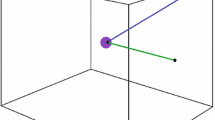Abstract
RECENTLY, Lyttleton and Bondi1 put forward the suggestion that the expansion of the universe is caused by the absolute values of the charges of the proton and electron not being equal, thereby giving a net charge to the hydrogen atom and causing mutual repulsion in the universe which may be considered as composed of a uniform distribution of hydrogen atoms. Inspection of the theory shows, however, that the 4-vector defined by electric current and charge is not Lorentz invariant and it is therefore of interest to see whether a Lorentz invariant system can be obtained.
Similar content being viewed by others
References
Lyttleton, R. A., and Bondi, H., Proc. Roy. Soc., A, 252, 313 (1959).
Watson, W. H., Proc. Second Symp. App. Math. Amer. Math. Soc., 49 (1950).
Chambers, Ll. G., Nature, 191, 262 (1961).
Milne, E. A., Relativity, Gravitation and World Structure, 75 (Oxford, 1935).
Whittaker, E. T., Aether and Electricity, 2, 41 (Nelson, 1953).
Author information
Authors and Affiliations
Rights and permissions
About this article
Cite this article
CHAMBERS, L. A Lorentz-invariant Universe with Charge Excess. Nature 198, 379–380 (1963). https://doi.org/10.1038/198379a0
Issue Date:
DOI: https://doi.org/10.1038/198379a0
- Springer Nature Limited





